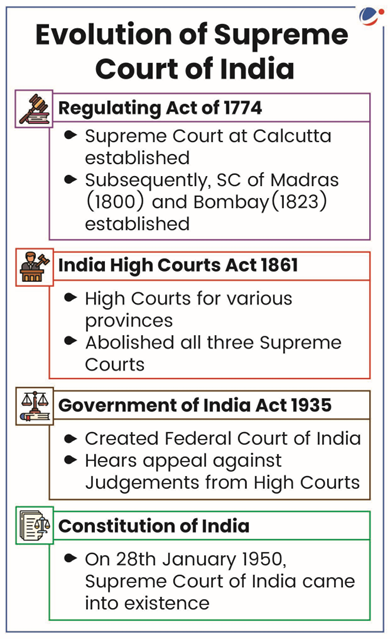Why in the News?
Recently, the Prime minister inaugurated the Diamond Jubilee celebration of the Supreme Court of India on 28th January at the Supreme Court auditorium in Delhi.
More in the News
- On the occasion, PM Launched multiple technology initiatives for the Supreme Court.
- Digital Supreme Court Reports: It will make Supreme Court judgments available to the citizens of the country free of cost and in electronic format.
- Digital Courts 2.0: Application is a recent initiative under the e-Courts project to make court records available to the Judges of the district courts in electronic form.
- The e-court mission, launched in 2013, aims to modernize India's court system by making it digital and improving access to justice.
- New website of Supreme Court: The new website will be in bilingual format in English and Hindi and has been redesigned with a user-friendly interface.
A glance at relations between judiciary and executive
|
About Supreme Court
- According to Article 124(1) of the Indian Constitution, the Supreme Court of India must have a Chief Justice of India (CJI) and a maximum of seven additional justices unless Parliament specifies a higher number through a statute.
- Currently, the Supreme Court comprises the Chief Justice and 33 other Judges.
- Constitutional Provisions: The Supreme Court's powers and jurisdiction are outlined in Articles 124 to 147 of the Indian Constitution.

Key Features of the Supreme Court of India
- Highest Court of Appeal: The Supreme Court is the highest appeal court is also known as the apex court of India and even the last resort, where the citizens of India can seek justice if they are not satisfied with the judgment of the High Court.
- Advisory Jurisdiction: As per Article 143 of the Constitution, the SC can advise the President of India that is related to the question of law, and the nature of the matter is associated with public importance.
- Adjudicate Federal Disputes: The Court resolves disputes between the Union and the states and between different states (Article 131).
- Judicial Review: The Supreme Court reviews laws and actions of the executive to ensure they comply with the Constitution.
- Protection of Fundamental Rights: The Court protects the fundamental rights of citizens by issuing writs and orders (Article 32).
- Public Interest Litigation (PIL): The Court can take up cases on its own or on behalf of the public interest. In some matters, the Supreme Court also acts on its own and can pass suo moto.
Challenges Faced by Supreme Court
- Massive Case Backlog: As of 2023, there were over 80,439 cases pending in the Supreme Court alone.
- Judicial Activism vs. Judicial Restraint: This debate revolves around the appropriate role of the judiciary in policy-making and governance.
- Uncle Judge Syndrome: The Law Commission of India's 230th Report highlighted a concern about potential favouritism in the appointment of judges to the High Court and Supreme Court, impacting the impartiality and fairness of the judicial system.
- Judicial-Executive Conflict: The judiciary and executive have faced rising conflicts, marked by delays in judicial appointments, the Tribunalisation of justice, and public criticism of the executive during COVID-19.
- Public Perception and Trust: There have been concerns about the public perception of the judiciary, including issues related to transparency, accountability, and judicial independence.
Way Forward
- Case Management and Technology: Implementing case management systems and leveraging technology for e-filing, video conferencing, and virtual hearings can help reduce case backlog and improve efficiency.
- Judicial Reforms: Implementing judicial reforms, such as increasing the number of judges, improving infrastructure, and filling up vacancies promptly, can help address the backlog and ensure timely justice delivery.
- Enhancing Transparency and Accountability: Transparency in the appointment of judges and making judgments more accessible to the public can help improve public trust in the judiciary
- Strengthening Judicial Independence: Ensuring that the judiciary is free from undue influence and interference from the executive or other branches of government can help maintain the integrity of the judicial system.



